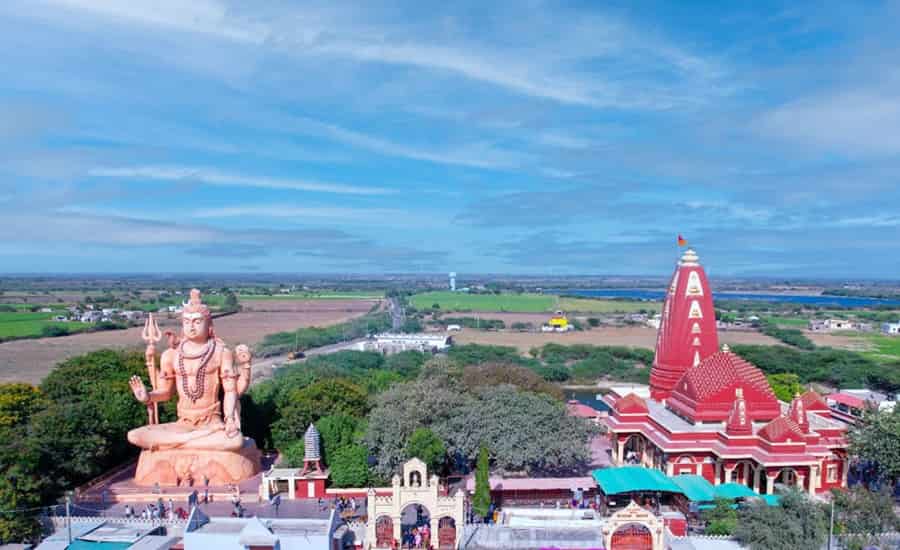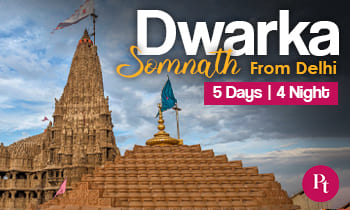Nageshwar Jyotirlinga Temple, located in Dwarka, Gujarat, India, is one of the twelve sacred Jyotirlingas dedicated to Lord Shiva. This ancient temple holds immense religious significance and is associated with rich history, mythology, legends, and stories. Let’s delve into the intricate tapestry of Nageshwar Jyotirlinga’s past.

Historical Background
The history of Nageshwar Jyotirlinga Temple is intertwined with the ancient city of Dwarka, believed to be the mythical kingdom of Lord Krishna. Dwarka, submerged under the Arabian Sea, is considered one of the seven most ancient cities in India. The temple, though not as ancient as the city itself, has roots that trace back thousands of years.
The current structure of the Nageshwar Temple is relatively modern, having undergone renovations over time. However, it is said to stand on the same spot where the original temple existed centuries ago. The temple’s history is a pilgrimage through time, reflecting the ebb and flow of dynasties, cultures, and religious practices that have shaped the region.
Mythological Significance
The Nageshwar sanctuary houses the revered Nageshwar Jyotirlinga, holding profound significance. As one of the first Jyotirlingas, it is deemed the divine locus of Lord Shiva’s celestial potency. This Jyotirlinga, with its unique prowess, serves as a guardian shield against various toxins, particularly those bestowed by serpents. This association is documented in the Sacred Rudra Samhita, identifying Nageshwar as Darukavana Nageswaram, linking it to Daaruka, denoting a forest. Further elucidation in the sacred text asserts that contemplation upon Nageshwar with untainted intent bestows liberation from physical and spiritual toxins, encompassing Maya, sin, anger, and temptation.
The nomenclature “Nageshwar” typically denotes the Cora, the sovereign serpent coiled perpetually around Lord Shiva’s neck. The conviction held by worshippers is profound – those who offer prayers at this sanctum remain impervious to harm from serpentine threats. This deep-seated belief underscores the temple’s paramount significance, attracting a multitude of devotees who seek its protective aura.
The Legend of Daaruka
According to the legend, Daaruka was a devotee of Lord Shiva but was misled by his power and became arrogant. He started tormenting the sages and other beings. To restore balance, Lord Shiva manifested as a Jyotirlinga at a place now known as Nageshwar. This Jyotirlinga was referred to as “Daarukaavana Nageshwar” or the Nageshwar of the Daaruka Forest.
Lord Shiva then slew the demon Daaruka, thereby liberating the world from his tyranny. The divine energy that emanated from Lord Shiva during this act is believed to have formed the Jyotirlinga at Nageshwar. The significance of this event is commemorated through the temple dedicated to Nageshwar.
Another Legend – The Aghori Connection
There is another intriguing legend associated with Nageshwar Jyotirlinga involving Aghoris, a sect of ascetics known for their unconventional practices. It is said that a group of Aghoris once tried to worship Nageshwar Jyotirlinga by offering meat and alcohol. Lord Shiva, pleased with their devotion but disapproving of their rituals, appeared before them and guided them towards a more virtuous path.
This legend reinforces the idea that devotion and purity of heart are more significant than external rituals, emphasizing the inclusive nature of Lord Shiva’s worship.
Nageshwar in Scriptures
References to Nageshwar Jyotirlinga can be found in various ancient texts, including the Shiva Purana. These scriptures describe the significance of worshipping Nageshwar for attaining spiritual enlightenment and divine blessings.
The Modern Temple
The current structure of the Nageshwar Jyotirlinga Temple is a result of continuous reconstruction efforts. The temple complex includes the main sanctum where the Jyotirlinga is housed, surrounded by smaller shrines dedicated to various deities. The architecture reflects a harmonious blend of traditional and modern styles, attracting pilgrims and tourists alike.
Religious Festivals and Celebrations
The temple witnesses vibrant celebrations during Maha Shivaratri, a festival dedicated to Lord Shiva. Pilgrims from different parts of the country gather to participate in the festivities, which include elaborate rituals, prayers, and cultural events.
Conclusion
Nageshwar Jyotirlinga Temple stands not only as a physical structure but also as a symbol of faith, devotion, and the triumph of good over evil. The legends associated with this sacred site continue to inspire millions of devotees, fostering a connection between the past and the present. As Nageshwar Jyotirlinga celebrates its place in history, it remains an enduring testament to the spiritual heritage of India.
Also Read:




 Call
Call WhatsApp
WhatsApp Enquiry
Enquiry